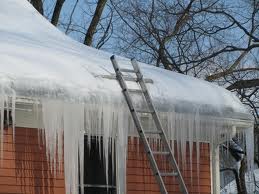Heavy snow on your roof creates dangerous, costly ice dams
By Kim Cox:
Blizzard Warning issued for MD and D.C.!
I’m sure you’re keenly aware of the impending blizzard headed this way…
It’s being reported as historic, with 1-2 feet of snow predicted in Maryland, and the Washington, DC area.
It’s gonna get bad, and I want you to stay safe.
But another important point I want to make is something you wouldn’t normally think about…

Your roof, ice dams, and lots of damage. (Yea… the giant icicles may look pretty – but don’t let them fool you – they are heavy and dangerous)
Plus, the sheer weight of 1-2 feet of snow on your roof could cause your roof to collapse under certain conditions.
What causes ice dams?
In a nutshell, ice dams are formed when snow on your roof melts, starts to run down your roof underneath the snow pack, hits the bottom edge of your roof, and freezes because the eaves are much colder.
You’ll usually see the giant icicles they create, which, if they were to break while you were under them, could severely injure you.
Once the melted snow freezes, it creates a dam, and when new melted snow runs down, it backs up further until it runs under the tops of the shingles.
Insufficient attic ventilation, and improper insulation are the two most important causes of ice dams.
Now it starts leaking inside your house, through your ceilings and down your walls.
Expensive repairs will usually be needed.
How to reduce or eliminate ice dams from forming
After the storm has passed and it’s safe, clear snow from the bottom couple feet of the roof. This will make it much harder for the dams to start.
A roof rake is a good way to begin. Or shoveling the entire roof, if necessary and appropriate. Hire professionals if need be. (It can be physically demanding)
Before it snows, make sure your gutters and downspouts are clear and free from debris.
How to get rid of ice dams if you do get them
First of all… Do not use axes, hammers, chisels, or other similar tools to chop ice. It’s dangerous to you, plus you’ll end up breaking and damaging shingles, gutters, or even your roof sheathing.
Remove the snow, at least from the bottom couple feet.
Fill up a sock or pantyhose with calcium chloride or salt, and throw it up onto the ice dam vertically. As it melts the ice, it’ll create a channel for the melting water to run off the roof instead of backing up onto the shingles and into your home.
If you can’t get on or safely reach the roof, or don’t want to use a ladder in snowy, icy conditions, then call a professional roofing contractor like us to remove the ice dam.
How to prevent ice dams from forming in the future
As I said earlier, there are two primary concerns.
The attic and roof needs the right amount and type of ventilation, and the attic/roof needs to be properly insulated to keep the roof temperature consistent from top to bottom.
As a licensed, professional Maryland roofing company, we’d be happy to come to your home and perform a thorough, detailed analysis of your attic ventilation and insulation.
Also, if you have any questions, or need help with snow removal, or ice dams after this blizzard, call us at 301-368-3551.
We’re here to help you, or refer you to someone who can, if necessary.
And for goodness sake… Please stay safe!
To get your free, no-obligation attic ventilation analysis,
call Kim at 301-368-3551
On Top Home Improvements, Inc.
10818 Avonlea Ridge Place
Damascus, MD 20872
Tel: 301-368-3551
Click to E-mail
